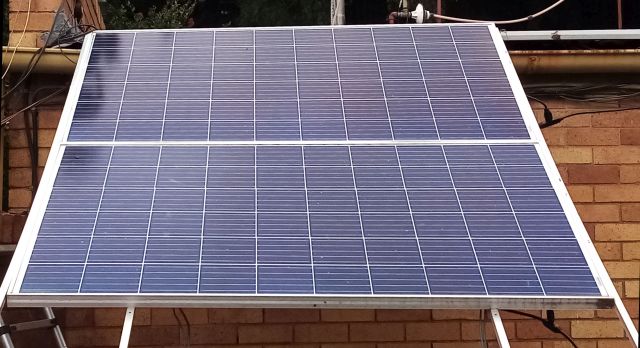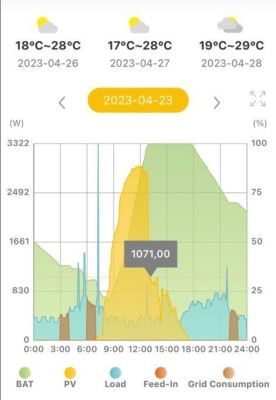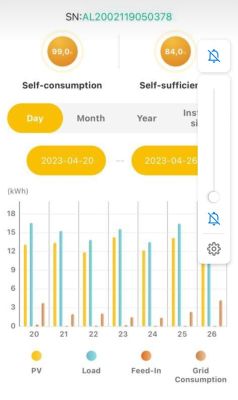
Going off grid with solar systems for South African conditions

Cost effective two panel base load solar solution
Realities
- Many appliances in the home need a lot of power for short periods.
- Being off the grid, one cannot get burst power for a short time from municipal grid.
- To cater for short term needs, the offgrid system has to be drastrically over capacitythe to cater for the nature of electricity loads around the home and the variation in solar power with weather
- Being completely off grid is NOT an economically viable solution
Case studies of converting solar to useful energy with battery systems
The purpose of adding solar panels to battery storage systems that have been driven by loadshedding, is to use thye solar energy to run the system.
A measure of success will be achieved by looking at how much energy you were buying from the municipality in the months before you installed the solar system, compared to the amount you are buying nowadays to keep you system running smoothly.This saving in energy bought is funding the capital outlay of the solar system.
For thoise who are looking to use their battery system for load shedding, they are likely to have set their control system to immediately recharge their battery after load shedding. If the load shedding happened at night, then the recharge will happen from the municipality at night, and when the sun comes up the battery will already be fully charged, meaning very little benefit from the solar panel part of the system.
Case study No 1
- Invoices before the installation
- JANUARY 2017 - 934kwh
Network Capacity Charge @ R4.68 per day for 34 days R 159.12
Energy Charge ( 0 - 600 kWh) 600 kWh @ R1.0929 /kWh : R 655.74
Energy Charge (> 600kWh) 334 kWh @ R1.7256 /kWh : R 576.35
The energy rate includes the 3.5 c/kWh cost of the environmental levy R 0.00
TOTAL CHARGES FOR BILLING PERIOD R 1,391.21
FEBRUARY 2017 - 687kwH
Network Capacity Charge @ R4.68 per day for 29 days R 135.72
Energy Charge ( 0 - 600 kWh) 600 kWh @ R1.0929 /kWh : R 655.74
Energy Charge (> 600kWh) 87 kWh @ R1.7256 /kWh : R 150.13
The energy rate includes the 3.5 c/kWh cost of the environmental levy R 0.00
TOTAL CHARGES FOR BILLING PERIOD R 941.59
MARCH 2017 - 663kwH
Network Capacity Charge @ R4.68 per day for 28 days R 131.04
Energy Charge ( 0 - 600 kWh) 600 kWh @ R1.0929 /kWh : R 655.74
Energy Charge (> 600kWh) 63 kWh @ R1.7256 /kWh : R 108.71
The energy rate includes the 3.5 c/kWh cost of the environmental levy R 0.00
TOTAL CHARGES FOR BILLING PERIOD R 895.49
- Invoices after the installation
- JANUARY 2023 - 66kwh
Network Capacity Charge @ R7.86 per day for 31 days R 243.66
Energy Charge ( 0 - 600 kWh) 66 kWh @ R1.8356 /kWh : R 121.15
TOTAL CHARGES FOR BILLING PERIOD R 364.81
- FEBRUARY 2023 - 62kwH
Network Capacity Charge @ R7.86 per day for 29 days R 227.94
Energy Charge ( 0 - 600 kWh) 62 kWh @ R1.8356 /kWh : R 113.81
TOTAL CHARGES FOR BILLING PERIOD R 341.75
- MARCH 2023 - 60 kwH
Network Capacity Charge @ R7.86 per day for 28 days R 220.08
Energy Charge ( 0 - 600 kWh) 60 kWh @ R1.8356 /kWh : R 110.14
TOTAL CHARGES FOR BILLING PERIOD R 330.22

Solar system management case 1 - A typical 24 hour cyctle
Key to 24 hour cycle graph.
- The green trace shows the available capacity in the battery.During the day it is charged until at 100% mainly from solar,
and then runs down during the night,
- The yellow graph shows energy from the solar panels which happens during the day. This energy is used to charge the battery and to supply the load during the day.
- The blue graph shows the load consumed by the home.
- The brown graph shows supplementary energy bought from the municipality to supply the load and ensure that the battery has a sufficient charge remaining in the morning before the solar can recharge. Mains energy is used to supply the load and only used to recharge the battery if solar energy is not performing.
- In South Africa the municipality do not at this stage allow Feed-IN, that is where surplus power is sent back to the grid.

Daily performance case 1
Key to Daily performance
- The yellow graph shows energy from the solar panels.
- The blue graph shows the load consumed by the home.
- The brown graph shows supplementary energy bought from the municipality.
- In South Africa the municipality do not at this stage allow Feed-IN, that is where surplus power is sent back to the grid.
- Performance of Case 1
- Before installation buying 761 kwh / month
- After installation buying 62 kwh / month.
- Saving at April 23 prices R1566-R113=R1453
- Independance=(1-62/761)=91.9%
Case study No 2
Battery and solar system with no management of software in the inverter. When power is off the inverter runs from the battery, and when power returns
mains powers the load and immediately charges the battery. When sun comes up in the morning, solar enery often not needed as battery full and mains dealing with load.
- Invoices before the installation
- Estmated monthly usage 350kwh
- Invoices after the installation
- Estmated monthly usage 250kwh
- Performance of Case 2
- Before installation buying 350 kwh / month
- After installation buying 250 kwh / month.
- Saving at April 23 prices R200
- Independance=(1-250/350)=28%
- Lots of Sun Power during the day
Track record.
Built a solar system in 2014 and have generated approx. 33000kwh from a system costing approx R30000. Have a 21.6 sq meter system of 21 panels and 7 mini inverters controlled by a computer to throttle down power when not needed.System can generate up to 3kwatts peak and maintain at this capacity if needed. Generate about 15kwh per day. Have no batteries and use municipal power to deal with peaks such as geyser, stove and motor startup. Generate about 60% of our daily needs from solar. Author is an Electrical Engineer educated at Wits University in the 1970s.
- Getting help and advice
- This description is provided to show how easy it is to get going. I am not selling anything, just encouraging users to take the first step.
You can contact me for help and advice from Mike at info@rapidttp.co.za
Tel +27 72 992 6040
Mike 10 May 2023
Also see an article on Smart Home using solar systems
Also see an article on Dealing with Load shedding at home
Also see an article on battery storage systems
Also see an article on Solar water heating - solar geysers
Also see an article on Measuring systems for solar systems
Also see an article on Energy equivalents
Also see an article on Gridtie inverters -Converting solar energy
Also see an article on Stand alone inverters -Converting battery energy
info@rapidttp.co.za




